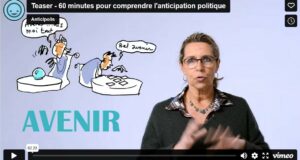Related to the GEAB article, “People’s anger: it’s politics stupid! “1, Jordi Lafon* offers us here an analysis of the hopes and possible risks brought by the democratic experiences of citizens’ assemblies that are multiplying, particularly in Europe.
As the European parliamentary democracies continue to run out of steam, new experiments in political representation are emerging in Europe. They constitute both a potential revival of the European construction but also possible frustrations that could fuel the increasingly radical social protests that are taking place across the continent.
The technique of the draw may be as old as politics itself, but in recent years it has been getting a new lease of life, particularly on the European continent. Several experiments have taken place and are under way in France, Scotland, England, Wales, Ireland, Spain, Belgium and Iceland. These are citizens’ assemblies randomly chosen according to criteria representative of the national population (gender, age, profession, geographical area, etc.) who are given a mission (to propose solutions to an issue such as climate change in France and England, or the revision of an existing law such as the right to abortion in Ireland). The results of the deliberations of these assemblies are then reintegrated into the political system, i.e. transmitted to the elected assemblies or to the citizens via referendum.
In order to formulate their proposals, citizens receive a very large amount of information on the subject under discussion, while listening to as many stakeholders from different sectors as possible. Meeting in plenary or in sub-groups, they deliberate on the basis of the information gathered and then gradually refine their proposals. They are supervised by facilitators who manage the organisation of the working sessions and the timetable, although citizens have a decision-making power as to the choice of speakers and even the organisation of the working sessions.
These experiments arose as a result of social protests or citizen lobbying of elected governments (Extinction Rebellion2 in England, Gilets citoyens3 in France, We The Citizens4 in Irelande). The most telling case is that of Ireland, as it has led to several referendums in which Irish citizens voted in favour of same-sex marriage and an end to the abortion ban in 20185
Proof of the effectiveness of the deliberative method exercised by the collective intelligence of a representative panel of citizens drawn by lot was therefore provided on this occasion, among others. If the work produced in these frameworks was considered serious, the most interesting point is that the scores of votes in the citizens’ assemblies follow very closely the scores of all voters in the referendum (in the case of the right to abort: 64% of votes in favour in the citizens’ assembly and 66% of votes in favour in the referendum). Some see this as a good reason to call on a “mini-public” (the Assembly drawn by lot) before consulting a “maxi-public” (citizens registered on the electoral rolls)6.
It is in this respect that the drawing of lots in the service of a form of deliberative democracy could constitute a democratic progress. The constitution of a panel of citizens representative of the population, much more faithfully than elected assemblies, charged with examining a specific problem, having sufficient time and means to gather information and confront contradictory points of view, … is capable of proposing solutions acceptable to the greatest number. It therefore constitutes a serious and effective alternative to the increasingly acute crisis that European representation systems have been going through for many years. It is applicable at different levels (local, regional, national, continental) since the challenge is simply to determine the representative criteria of a given population. Then, whoever has the logistical and financial means to do so can set up an assembly drawn by lot that respects the criteria that have proved their worth in past experiences.
The coexistence of the elected and drawn assemblies in question
While the effectiveness of the process has been proven, the problem lies in the fate of the work that emerges from the deliberations. The establishment of a citizens’ assembly does not guarantee the implementation of proposals, even when it is followed by a referendum. In Iceland this has been the case. In 2011, a referendum was held on the draft constitution7 developed by an assembly, first drawn by lot and then drafted by a second assembly – which was elected but from which members of the political class were excluded. The draft was approved by referendum but then blocked by successive majorities in parliament. In Belgium, the citizens’ assembly had no mandate, in the Netherlands no referendum was held. Ireland is therefore an exception, mainly because the constitution cannot be amended without the citizens’ agreement expressed in a referendum and because the subjects dealt with were considered too sensitive by the elected representatives, who saw an interest in entrusting it directly to the citizens.
In the current cases, particularly French and British, no guarantee has been provided as to the fate of the proposals. The British Government simply undertook to forward the proposals to Westminster8 and Emmanuel Macron, invited to exchange with the citizens drawn on 10 January 20209 insisted that he would retain control over the outcome of the Convention’s work, although he undertook to report back to the same assembly. The risk then is that citizens will end up with the feeling that these innovative forms of democracy serve above all to legitimise political projects that are difficult to pass. The studious and determined work of citizens could be followed by a serious and dangerous frustration resulting from the feeling that governments “pretend to question everyone but continue not to listen to anyone”.10.
More broadly, the question of cohabitation between elected assemblies and assemblies drawn by lot arises. In past examples, the elected assemblies have not welcomed the work of those drawn by lot with much enthusiasm, except in the Irish case where, once again, the MPs saw an interest in it since the subjects dealt with were particularly controversial and therefore potentially very costly from an electoral point of view. When they do not see a direct interest, MPs see the drawn representation as a threat instead. In a configuration where national representation would be drawn by lot and its work directly transmitted to citizens via referendum, their role seems, at first glance, to have become obsolete. For this reason, elected assemblies tend to see lottery experiments as inconsiderate and unnecessary risks taken by governments, as is the case with some members of the majority in the French National Assembly11.
Yet the crisis of representation is at the heart of the crisis of democracy on the European continent and, with the same causes producing the same effects, if citizens’ mistrust of their representatives is not addressed quickly, it will only get worse. Citizens’ assemblies drawn by lot are therefore an interesting alternative to be explored by governments and parliaments, which would thus demonstrate their commitment to responding to the mistrust signals sent to them by citizens. Significantly, the constitution of a Citizens’ Assembly to take over Brexit has been mentioned, notably in the Guardian, by various personalities : Lords, NGOs, or researchers12, but also more recently by democracy reform activists and a former minister13.
Brexit is a clear and striking example of the rupture between citizens and their representatives, since it is above all a political will emanating from the citizens, expressed by referendum, which their elected representatives find so difficult to implement.
Two scenarios could thus develop in the future:
. if the results of the work of the assemblies drawn by lot were to be treated randomly by the elected representatives, this would fuel the revolutionary tide as a result of disappointed promises in a democratic model closer to the citizens, as the political class in power would thus openly show that it is not ready to share power with the very people who have mandated it. This could only lead to a radicalisation of citizens’ demands against the representatives, tending to directly call into question the existence of elected assemblies.
. otherwise, the recommendations of the assemblies drawn by lot could be treated seriously by parliamentarians, possibly amended and then debated before being put to the citizens’ vote by means of a referendum. In this case, a reform of our democratic systems would gradually be set in motion, which could lead to the institutionalisation of the lotteries with the regular organisation of this type of Convention on different types of subjects. A back-and-forth system of texts could be set up, as is currently the case between the different elected chambers. The elected representatives would then respond directly to the crisis of representation and thus to a significant aspect of the democratic crisis. They would participate in the reform of their own status. From a legislative chamber it could become a chamber of control and would accompany the work and decisions of the citizens expressed through the drawing of lots and referendum votes, check that they comply with the constitution and international treaties and provide citizens with the tools necessary to achieve the objectives and recommendations they have set themselves.
These scenarios apply both to the national systems and to the European Parliament and the Commission, which face at least as much mistrust, even if social movements are less often directly aimed at them.
A potential for relaunching European construction
We have just seen that, depending on the attitude adopted by governments and elected assemblies, citizens’ assemblies carry with them both a potential danger on the social level if they lead to frustration on the part of participants and, by extension, citizens, but also an opportunity if they are followed up by concrete results. A form of deliberative democracy based on the drawing of lots would be particularly relevant at the European level because it corresponds in many respects to the European method as described by Franck Biancheri in his 1992 book Europe: Community or Empire?14
“The European construction is endowed with one of the most innovative principles, namely respect for diversity or respect for minorities… this is because each of the peoples within it, no matter how great, has become a minority” as the author demonstrates. The drawing of lots allows a faithful representation of the European people and all its social and demographic components, a representation which seems to be out of reach by the current electoral system responsible for the people’s mistrust of elected representatives.
For Franck Biancheri, the whole debate on subsidiarity at the beginning of the 1990s was “in fact only a debate on the definition of the operational instruments needed to put this respect for diversity into practice“. These two principles combined and respected in the exercise of the European Community method would have made it possible to avoid “any dictatorship of a minority” and to work towards the realisation of the ideals of peace and prosperity which are the original promises of the European construction. Institutionalizing assemblies of randomly selected citizens deliberating democratically on given subjects is an operational instrument capable of putting respect for diversity into practice and giving rise to concrete solutions, emanating from a panel of citizens representative of the European population, that are likely to be accepted by the greatest number.
Nevertheless, integrating processes of deliberative democracy within the European institutions implies going beyond the consensualist project deconstructed by Chantal Mouffe in The Illusion of Consensus15. She shows that the emergence of the so-called “third way” has led to a loss of democratic legitimacy that endangers political institutions. The reduction of politically expressible options partly explains the undemocratic populist wave. This is because citizens are no longer able to express themselves through the right/left opposition, so “passions can no longer be mobilized for democratic purposes, and antagonisms take forms that may endanger democratic institutions”.16.
If we consider, like Franck Biancheri does, that “the Community or Europe are not and must not become ideological instruments“, deliberative citizens assemblies are a relevant process. The citizens participating in the Convention in France clearly describe that they first discuss concrete measures, before knowing whether the person they are talking to is right or left. In the second stage, of course, these affiliations resurface, but they are relegated in comparison with an assembly formed after a partisan election. Then, once the recommendations resulting from the citizens’ deliberation are returned to the public arena, and ideally submitted to a referendum, an ideological debate can take place. Agreeing to recognize the validity of the citizens’ deliberation, the different parties to the debate thus enter into what Chantal Mouffe conceives as “agonism“, a conflictual we/them relationship but in which each recognizes the legitimacy of his/her opponent. This situation is in opposition to the current antagonism, a we/them relationship in which the parties consider themselves enemies and do not share a common base. Since “agonism” is only possible when the different parties to a debate agree on a common basis, this common basis can be constituted by the assemblies, their legitimacy, their methodology, the conditions of their functioning and the recommendations they make.
The choice to reconnect with citizens
We therefore believe that European leaders have a clear choice. Continuing in the rupture that currently seems unsurpassable and will only produce the same effects. The mistrust of our systems of representation is only increasing and is feeding the revolutionary tide which will not recede until a significant change of system is achieved by those who carry it. The dialogue is broken, and despite a slight increase in turnout at the last European elections, the current occupants of the European institutions are far from enjoying satisfactory legitimacy.
Reaching out to the people and summoning them to take a direct part in a deliberation on the scale of the European continent could put the Euroipean construction back where it was at the end of the last century, namely “the most successful political innovation attempting to go beyond the nation-state on the basis of the values of democracy and respect for diversity” in the words of Franck Biancheri
Considering in particular the holding and future conclusions of the French Citizens’ Climate Convention17 and of the English Citizens’ Assembly on Global Warming18 , everyone agrees that this dossier should ideally be managed on a European if not a global scale. And this is not the only theme that could be approached in this way. Gráinne de Búrca considers migration policy meets all the relevant criteria for being the subject of a Europe-wide citizens’ assembly, knowing that the existing system is in a deadlock, unable to agree on the solutions, with a sense of urgency that has led to frustration on the part of public opinion19.
More broadly, European political representatives need to take the tool provided by the citizens assemblies more seriously as they themselves consider to consult the citizens they wish to call upon in the context of the conference on the future of Europe starting this year.20.This is an ideal opportunity for the Parliament or the Commission to take the lead in an international policy innovation, knowing the scale of the process and the fact that it would have initiated it on its own and not under pressure from this or that body in society.
* Jordi Lafon is part of the LEAP2040 junior team. French, 27 years old, he is a journalist.
Notes:
4Source : WeTheCitizens.ie
5Source : Electoral Reform Society, 29/05/2018
6Source : La vie des idées, 05/03/2019
11Source : Lefigaro.fr, 26/11/2019
12Source : Theguardian.uk, 16/12/2018
13Source : Theguardian.uk, 04/11/2019
16Source : Les Philosophes, 2016
18Source : The Guardian, 22/01/2020
19Source : Cambridge.org, 01/2020
20Source : Europarl.europa.eu, 15/01/2020


 LEAP2040 Toutes les informations et archives Europe2040
LEAP2040 Toutes les informations et archives Europe2040



